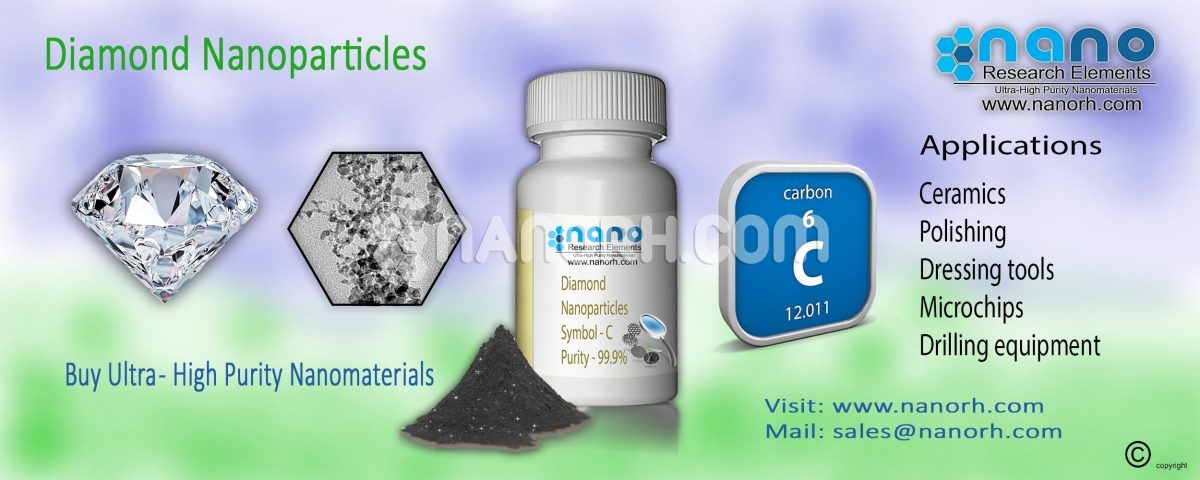Diamond Nanoparticles
DIAMONDS NANOPARTICLES
INTRODUCTION
More than 40 years ago, scientists discovered that Diamond Nanoparticles were formed as a product of detonation of carbon-based explosives. For several reasons, including the safety measures and the lack of industrial interest in nanotechnology at that time, the application of these Diamond Nanoparticles remained little exploited until recently. However, in recent years there has been a clear increase in interest in the use of Diamond Nanoparticles particles in a wide range of applications. Preliminary reports on the use of Diamond Nanoparticles in fields as diverse as catalysis, quantum computing, and biology seem to indicate a field on the verge of massive expansion. Other examples of the application of Diamond Nanoparticles can be found in the formation of hard and composite coatings, polishing and seeding of substrates for chemical vapor deposition (CVD) in diamond growth. Diamond nanoparticles, also known as Diamond Nanoparticles, is composed of monocrystalline diamonds from 5 to 500 nanometers. Depending on the application, different sizes, compositions with other powders and other factors can change the ideal. The Diamond Nanoparticles allow an extremely precise sharpness even of the roughest surfaces, which makes them a very preferred coating for such tasks. Along with this, it is used as a protective coating, as if the addition of diamond nanopowders on a protective coating can greatly improve its resistance to damage at a relatively low cost. It is also used in resins, ceramics, rubbers, and many other compounds; Diamond nanopowder improves durability and strength. A new analysis indicates that there are interesting possibilities for Diamond Nanoparticles in quantum computing and alternative quantum engineering arrives. Recent studies have confirmed that it is possible to use Diamond Nanoparticles for the assembly of nanocomposite materials, selective and adsorbent catalysts, nanoelectronic elements, and materials used in biology and medicine. The Diamond Nanoparticles are able to improve the standard of magnetic recording systems, rubber and Indian rubber, polymeric compositions, abrasive tools, lubricants, and abrasive and polishing compounds. The applications for Diamond Nanoparticles in catalysis relate mainly to its use as solid catalyst support; however, a direct role for the Diamond Nanoparticles itself in the catalysis of the oxidation of CO to CO2 was recommended. It was found that untreated Diamond Nanoparticles dust oxidizes CO to CO2 from 2308 ° C and reaches a maximum efficiency of 80% of 3808 ° C. In general, catalytic materials based on Diamond Nanoparticles showed better activity, with a direct correlation between the decomposition rate of methanol and the amount of Diamond Nanoparticles incorporated in the catalyst. Recent studies have confirmed that it is possible to use Diamond Nanoparticles for the production of nanocomposite materials, selective catalysts, and adsorbents, nanoelectronic elements, and materials used in biology and medicine. Diamond Nanoparticles are capable of improving the quality of magnetic logging systems, Indian rubber and rubber, polymeric compositions, abrasive tools, lubricants and abrasion, and polishing compounds. Diamond Nanoparticles demonstrate superior optical and mechanical properties. They have adjustable surface structures and high surfaces. They are ideal for biomedical applications due to their non-toxicity. They found use in applications such as tissue engineering, bioimaging, drug administration, and tribology. The filler material can work for nanocomposites and as mimics for macromolecules. In addition, Diamond Nanoparticles have many alternative characteristics of nanomaterials, including the macroscopic quantum tunneling effect, the quantum dimension effect, the surface/interface effect, and the small effect.
APPLICATIONS
The following are some of the applications of raw diamond/graphite nano mixture and pure Diamond Nanoparticles:
CATALYSTS
Some types of Diamond Nanoparticles have an Associate in a complex structure that includes a diamond core and a cover similar to graphite with a practical cover on its surface. It is necessary to activate and activate the surface of the Diamond Nanoparticles for the chemical action functions. Catalysts based on Diamond Nanoparticles have been evaluated in the conversion of CO to CO2. The electrochemical modification of a saline solution and the surface of the diamond nanopowder with metal is able to provide electrodes and catalysts of low-temperature fuel components.
PLANTING MATERIAL TO GROW DIAMOND FILMS
Diamond Nanoparticles used in analyzes performed on artificial CVD diamond films. High-density diamond nucleation centers are created on many alternative substrates by the radical victimization of dispersed radical nano-diamond. These substrates are then coated by depositing high-quality doped diamond films from a gas phase of microwave discharge. Selective nucleation will generate diamond grids with completely different transparency. The resulting high-quality doped diamond grids promise to be used like most prospective electrodes for electrochemistry.
Additives for automobile oils
For lubricants, ultra-dispersed diamonds can offer a new class of additives, specially designed to protect and restore the clutch units in different mechanisms and machines, optimizing the protection properties and the effective life of the lubricants.

